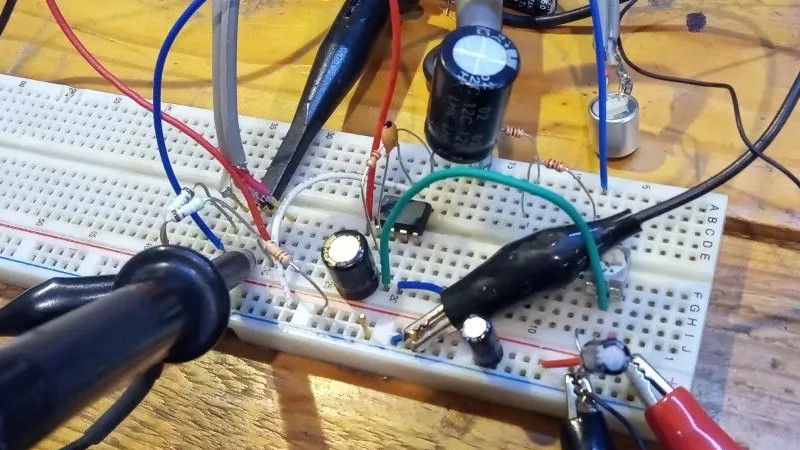Before the invention of microelectromechanical system (MEMS) microphones, almost all microphones in cell phones and other electronics were a type of condenser microphone called the electret microphone. The fact that this type of microphone is cheap and easy enough to place into consumer electronics doesn’t mean they’re all low quality, though. Electret microphones can have a number of qualities that make them desirable for use recording speech or music, so if you have a struggling artist friend like [fvfilippetti] has who needs an inexpensive way to bring one to life, take a look at this electret microphone pre-amp.
The main goal of the project is to enhance the performance of these microphones specifically in high sound pressure level (SPL) scenarios. In these situations issues of saturation and distortion often occur. The preampl design incorporates feedback loops and an AD797 opamp to reduce distortion, increase gain, and maintain low noise levels. It also includes an output voltage limiter using diodes to protect against input overload and can adjust gain. The circuit’s topology is designed to minimize distortion, particularly in these high SPL situations.
Real-world testing of the preamp confirms its ability to handle high SPL and deliver low distortion, making it a cost-effective solution for improving the performance of electret microphones like these. If you want to go even deeper into the weeds of designing and building electret microphones and their supporting circuitry, take a look at this build which discusses some other design considerations for these types of devices.















Before anyone jumps in to complain about the readability of the source or the breadboard layout, study what the circuit is actually doing. Sure, it’s textbook stuff, but it’s a great example of someone *understanding* how to make a circuit better. Oftentimes people pay little attention to those details that can make a big difference in the performance. “Meh, it works good enough” means “I’m too lazy to figure out what makes this circuit work.”
“I’m too lazy to figure out what makes this circuit work.”
Sure, it’s fun to noodle about with circuits, I do it a lot and it does help in understanding but it can also mean *exactly* what it says.
Oftentimes you really don’t need to improve stuff over the app note or the same old circuit that’s been rolled out *everywhere* because it really does work perfectly well for the intended purpose and there’s no benefit to spending hours improving it.
If this a way to compress levels with a single op-amp and accessory parts I get it on principle, but I’ve used these telephone answering machine and desk-set microphones as direct pickup contact mics for years and no distortion with the right gain. Please leave compression out of this path. The op-amp in the path needs gain control via feedback and that’s about it maybe some high freq cut.
I gave a demo holding a pair on for a nationally known hammered dulcimer player not satisfied with Fishman pickups and other slender pro-microphones held inside. He was happy. These mic capsules beat any piezo disc pickup, running on 9V. I haven’t had a try with these MEMS devices as pickups, should be great.
What do you mean? It has a feedback network.
Clearly didn’t read the linked article. Or even comprehend the intro blurb here.
I object to the framing in this writeup (“enhance the performance”, “improving the performance of electret microphones”) ; it implies that electret mics have deficiencies that this circuit somehow overcomes. In reality, the linked article seems to be just an exercise in more appropriate gain-staging for the intended use which is to employ an unspecified 3-terminal electret mic capsule for close or high-spl sources. There’s also no mention of what the output of this mic is intended to feed.
There are many available high quality, modest cost electret mic capsules available for different applications, including for high spl. And more elegant solutions for interfacing and power. Info here: https://groups.io/g/MicBuilders
FTA: “On of the worst problems of electret microphones is the saturation and posterior distortion of the internal Jfet transistor,”
No, it’s not. I’ve built a stereo microphone using two Panasonic WM61 capsules and could record my former rock band at full volume in a small rehearsal room without any appreciable distortion. Noise wasn’t a problem as those capsules are less noisy than commercial ones used in portable devices but for quieter music I would either use a pair of dynamic ones followed by a good preamp (a single low noise jfet will suffice, been there done that) or a better electret capsule possibly followed by a buffer with very low or no gain at all, just to lower their output impedance, which could have been the source of problems.
An interesting part I plan to test one day is the AOM-5024*, which is cheap and rated for a whopping 80db s/n.
https://puiaudio.com/product/microphones/aom-5024l-hd-r
AOM-5024 are very sensitive low-noise omni electret capsules – really great for field recordings – but they are rated for only about 110dB spl max, so not the best choice for close or high-spl use as specified in the linked article.